Art and science in Tuscany

Starting from the middle of the 15th century the figure of the artist-engineer emerged, that is, the painter, sculptor or architect who was also expert in the sciences of military technology, mechanics and hydraulics. This figure of highly versatile intellectual includes such famous names as those of Filippo Brunelleschi, Francesco di Giorgio and Leonardo da Vinci. With the rise of Medicean power, the scientists found in the Prince an erudite patron of the arts, thanks to whom academies destined to make history in European scientific research were founded.
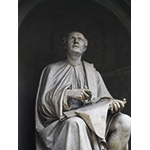
The artists-engineers
Filippo Brunelleschi was the designer of the most extraordinary architectural undertaking of the Renaissance, the Dome of Santa Maria del Fiore in Florence. Completed between 1420 and 1436 (except for the lantern), it was constructed without centring to support the masonry. It is calculated that four million bricks were used. To Brunelleschi we also owe the invention of linear perspective, on which the science of art, destined to revolutionise figurative culture, was based. Masaccio, in his Trinity at Santa Maria Novella, created one of the first and most convincing documents of the application of Brunelleschi's new theories.
Taccola and Francesco di Giorgio
In Siena, Mariano di Iacopo, known as Taccola, and Francesco di Giorgio accomplished numerous drawings of civil and military machines, revealing sound technological research. Taccola, who was called the "Archimedes of Siena", in significant homage to the science of antiquity, left the four books of De ingeneis and De machinis. In them he described hydraulic projects, systems for lifting water, measurement techniques, machines for civil applications and for war. Even more numerous are the drawings left by Francesco di Giorgio, architect, painter, sculptor and expert miniaturist. Francesco di Giorgio, who was also a worker at the Bottini of Siena, designed techniques for walking on water and for navigating, as well as for surprise fountains, war machines, column raisers, winches and cranes, wagons and mills. His work bears witness to the vivacity of a technical-scientific culture that was able to imagine, anticipating Leonardo's intuitions, such things as flight and parachute landing.
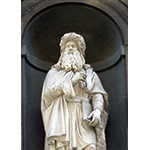
Leonardo da Vinci
Leonardo da Vinci investigated every branch of knowledge: from anatomy to botany, to hydraulics, mechanics, geometry, physics, the military sciences, the mysteries of flight, and physiognomy, down to simple rebuses serving to train the mind. He believed that the natural world could be investigated, interpreted and revealed only by the eye of the artist. The figure of Leonardo, for whom painting was the science par excellence, was unique and inimitable, testifying to how the relationship between art and science was one of the basic nodal points of Renaissance culture.
Art and anatomy
With the Lesson in which the greatest of the arts was discussed, presented at the Accademia Fiorentina in 1547, the erudite Benedetto Varchi emphasised the importance of painting for the sciences of anatomy, astronomy, botany and zoology. In fifteenth- and sixteenth-century treatises on art, the connections between the arts and the study of the human body were precise. From Leon Battista Alberti, to Giorgio Vasari, to Alessandro Allori, drawing and studying anatomy were deemed indispensable factors in the training of an artist. Leonardo dissected cadavers in the Hospital of Santa Maria Novella. The Florentine Academy of the Drawing Arts also conducted dissections in public. The Florentine physician Guido Guidi commissioned Francesco Salviati to illustrate his Raccolta di Chirurghi Greci, while near the end of the 16th century the painter Ludovico Cardi, known as Cigoli, became a friend of the French anatomist Théodore De Mayern, who was then staying in Florence. Documenting the friendship between the artist and the French physician is the Scorticato [the flayed man], a bronze statuette now in the Bargello National Museum, sculpted by Cigolo on the basis of precise anatomical knowledge.
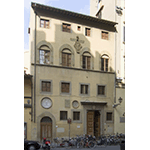
Art and astronomy
At the Florentine Accademia della Arti del Disegno, Euclidean geometry and mathematics were also taught. Many painters were fascinated by astronomy. Cigoli, a close friend of Galileo Galilei, was struck by the images of the Moon included by the Pisan scientist in his Sidereus Nuncius [Starry Messenger] published in 1610. The Virgin of the Immaculate Conception frescoed in the Paoline Chapel in Rome contains the first representation in a painting of Galileo's Moon, no longer smooth but with a rough surface, as it would appear observed through a telescope. In 1613 Galileo was named a member of the Accademia fiorentina delle Arti del Disegno.
Naturalist illustration
The Medici family were passionate admirers of naturalist illustration. Francesco Bachiacca, described by Vasari as a "painter excelling at portraying all sorts of animals", decorated for Cosimo I "a desk all full of birds of different kinds and rare plants". The room of the geographic maps in the Guardaroba of Palazzo Vecchio, commissioned by Cosimo of Egnazio Danti, contained maps of all of the known countries and under them, as reported by Vasari, "all of the plants and all of the animals portrayed as in nature, according to the kinds those countries produce".
In the Pisa "Giardino dei Semplici" there was an art workshop which accompanied with refined tempera paintings the research carried out by the "prefects" Andrea Cesalpino, Giuseppe Casabona, and Francesco Malocchi. Among the artists engaged in depicting plants and animals were the German Daniel Froeschl and the Pistoian Filippo Paladini. Jacopo Ligozzi, an artist from Verona, worked for Grand Duke Francis I. His tempera paintings of plants, birds and fish aroused the wonder of the scientists. The naturalist from Bologna, Ulisse Aldrovandi, staying in Florence in 1577 at the invitation of the Grand Duke, wrote of Ligozzi's work, "nothing is missing but the spirit". The images of plants and animals, but also of glasses and Turkish costumes, drawn by Ligozzi and now in the Drawings and Prints Cabinet of the Uffizi, constitute the highest testimony of the extraordinary possibilities of naturalist illustration.
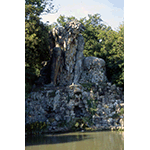
The Prince of the Studiolo
For Francis I, the Prince of the Studiolo, fervently interested in science and magic-alchemistic practices, many artists worked, among them Bernardo Buontalenti. His are the projects for Pratolino, with its waterworks and automatons, for the Tribuna in the Uffizi and for the Casino di San Marco. In the Casino di San Marco, mountain crystal was melted, porcelains, glassware, goldsmith's objects and crystals were produced. A crucially important event in the relationship between art and science was the founding of the Opificio delle Pietre Dure, engaged for years in decorating the Chapel of the Princes in San Lorenzo.
In every branch of knowledge, as indicated expressly by the Prince's Studiolo, art and science were melded in perfect harmony. Girolamo della Volpaia, the grandson of that Lorenzo della Volpaia who had constructed the famous planetary clock for Lorenzo the Magnificent, built splendid armillary spheres as well as ingenious clocks and dials. A true masterpiece is the great armillary sphere of Antonio Santucci, begun on March 4, 1588 and completed on May 6, 1593, now in the Institute and Museum of the History of Science in Florence.
-
 Casino Mediceo di San Marco [Medici Lodge in San Marco]
Casino Mediceo di San Marco [Medici Lodge in San Marco] -
 Galleria degli Uffizi [Uffizi Gallery]
Galleria degli Uffizi [Uffizi Gallery] -
 Museo Galileo - Istituto e Museo di Storia della Scienza [Institute and Museum of the History of Science]
Museo Galileo - Istituto e Museo di Storia della Scienza [Institute and Museum of the History of Science] -
 Museo delle Cappelle Medicee [Museum of the Medici Chapels]
Museo delle Cappelle Medicee [Museum of the Medici Chapels] -
 Museo dell'Opificio delle Pietre Dure [Museum of the Opificio delle Pietre Dure]
Museo dell'Opificio delle Pietre Dure [Museum of the Opificio delle Pietre Dure] -
 Parco Mediceo di Pratolino - Villa Demidoff [Medici Park at Pratolino - Villa Demidoff]
Parco Mediceo di Pratolino - Villa Demidoff [Medici Park at Pratolino - Villa Demidoff] -
 Girolamo della Volpaia
Girolamo della Volpaia -
 Lorenzo della Volpaia
Lorenzo della Volpaia -
 Lorenzo della Volpaia's planetary clock
Lorenzo della Volpaia's planetary clock -
 Glassware in Tuscany
Glassware in Tuscany -
 Lorenzo della Volpaia's planetary clock
Lorenzo della Volpaia's planetary clock
-
 Girolamo della Volpaia's armillary sphere
Girolamo della Volpaia's armillary sphere
-
 Nocturnal and sundial
Nocturnal and sundial
-
 Polyhedral dial
Polyhedral dial
-
 Horary quadrant
Horary quadrant
-
 Antonio Santucci's Armillary sphere
Antonio Santucci's Armillary sphere
Paintings and wax figures in seventeenth-century Florence
In the first half of the 17th century, artists who were to bring about major developments in the still-life genre and in naturalistic illustration arrived in Florence: foremost among them, Filippo Napoletano and Giovanna Gazzoni. Near the end of the century, the Sicilian wax modeller Gaetano Zumbo arrived at the grand-ducal court. In contact with Francesco Redi, he accomplished not only splendid anatomical figures but also scenographic compositions that aroused the wonder and admiration of doctors and scientists.
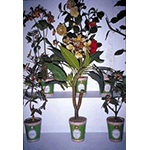
Art and Science in the 18th century
For the villas of Careggi, Ambrogiana and Castello, Grand Duke Cosimo III commissioned Bartolomeo Bimbi and Andrea Scacciati to paint great canvases depicting fruits, flowers, the citrus trees grown in the Medicean gardens and the animals kept in the court menageries. Monstrous pumpkins, gigantic oranges, splendid exotic birds, but also precise examples of fruit and vegetables, now in the Florence Botanical Museum, were closely linked to the botanical research conducted by Pier Antonio Micheli. During the course of the 18th century, some important publishing initiatives were undertaken. One of the most beautiful of these was the Storia naturale degli Uccelli by Saverio Manetti, printed between 1767 and 1776, illustrated with elegant plates by Violante Vanni and Lorenzo Lorenzi. The originals, formerly in the Pisa Museum of Natural History, are now found at the University of Pisa Library.
Art and Science in the 18th and 19th centuries
At the close of the 18th century, the tradition of the Florentine wax modellers was still alive. In 1782 Clemente Susini, assisted by Giuseppe Ferroni, modelled for the Museo di Fisica e Storia Naturale a fascinating Venus made of detachable parts. The tradition continued into the 19th century, thanks to Susini's pupil, Francesco Calenzuoli, and to the self-taught chemist Luigi Calamai. Their anatomical and botanical prepared specimens were made under the guidance of the most authoritative scientists, such as Giovanni Battista Amici, who advised Calamai on the realisation of particularly complex specimens.
We owe to Paolo Mascagni the most beautiful nineteenth-century anatomical work. In 1823, seven years after his death, his Anatomia universa, the monumental work to which the scientist had devoted himself for years, was published in Pisa. The superb plates were done by Antonio Serantoni. An expert naturalist illustrator, Serantoni also made the plates for the Flora Italiana by Gaetano Savi, published in Pisa between 1818 and 1824, and for the Pomona Italiana by Giorgio Gallesio, one of the most beautiful works of European garden literature. Another volume outstanding for the beauty of its iconography is the Raccolta di fiori, frutti e agrumi by Antonio Targioni Tozzetti, printed in Florence in 1825, and the Antotrofia, that is, the cultivation of flowers, published in 1834 by Antonio Piccioli, gardener of the Florence Museo di Fisica e Storia Naturale. During those same years, in the Pisa Museum of Natural History, Paolo Savi made groups of stuffed animals that were judged insuperable works of art by scientists all over the world.
In 1841, on the occasion of the third Congress of Italian Scientists, the Tribune of Galileo was built, to the project of the Florentine architect Giuseppe Martelli. A monument unique of its kind, the building was designed to present an iconographic synthesis of experimental science. In a rich array of iconographic references, the instruments, the scientific discoveries and the scientists who made them possible are depicted.
****************************
Texts by Alessandro Tosi
English translation by Catherine Frost
Last update 19/gen/2008


